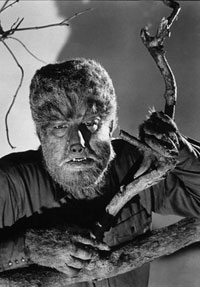 A watershed werewolf film was The Wolf Man (1941) with a watershed performance in the key role from Lon Chaney Jr.
A watershed werewolf film was The Wolf Man (1941) with a watershed performance in the key role from Lon Chaney Jr.
Lon was long regarded in the same breath with Bela Lugosi, Boris Karloff & Peter Lorre as the crown princes of Universal horror films.
But whereas that great triumverate of Bela-Boris-Peter made numerous excellent horror films, Lon had a rapid decline, & most of his horror films are of secondary interest or importance.
Thus his reputation hasn't kept him in the firmament with the greatest of the great. And yet for the compassion, sensitivity, & terror The Wolf Man remains sufficent legacy.
The story was a lot less familiar in 1941 than it would be forever after. Larry Talbot (Chaney) saves the life of a girl (Fay Helm) when he kills a werewolf (Bela Lugosi in a veritable cameo appearance).
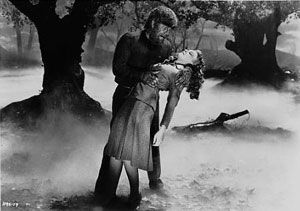 Talbot believed he had killed only a wolf, & is reluctant to accept that the corpse was that of a man. Talbot believed he had killed only a wolf, & is reluctant to accept that the corpse was that of a man.
He is in love with Gwen Conliffe (Evelyn Ankers) & as heir to a large estate expects a blissful future. But that future comes undone when he realizes the wolf-bite has changed him, & by each full moon, he becomes a man-wolf who must kill.
As with many Universal horror films, it's not enough that the monster dies at the end, but we must feel sympathy for him.
The Wolf Man even more than most makes Tragedy of Horror, with an intelligent script by Curt Siodmak, fine acting from an array of the finest character actors the studio possessed (Claude Rains, Maria Ouspenskaya, Ralph Bellamy...) & evocative sets. Classic, classic, classic!
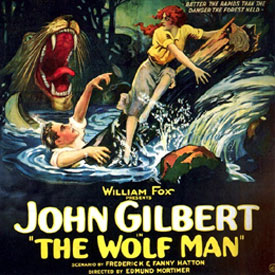 How much or how little Lon's classic film owes to the silent film The Wolf Man (1924) can never be known.
How much or how little Lon's classic film owes to the silent film The Wolf Man (1924) can never be known.
It was not a werewolf movie, but the concept of the wolf man as split personality induced by alcoholism rather than the full moon was at the heart of this lost movie.
John Gilbert was the alcoholic, gentle & kind when not drinking, a man who comes dangerously close to rape & murder of his beloved (Norma Shearer) when drunk.
The chase across the countryside to stop the "mad man," & the endangered damsel who forgives & even falls in love with her near-rapist, are elements that might've borrowed from Jekyll & Hyde or werewolf legendry. What's more certain is Lon Chaney's love story within his classic film owes a great deal to Victorian melodrama, such as had long infused silent cinema.
Even earlier was The Wolf Man (1915) is likewise lost, but was a crime & murder tale set in a ceramics company, an early tale of industrial espionage.
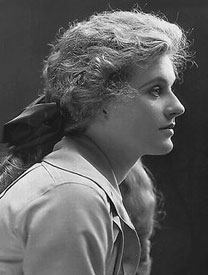 There was, however, a legitimate supernatural silent film on the topic, The Werewolf (1913), from Canadian director Henry McRae. There was, however, a legitimate supernatural silent film on the topic, The Werewolf (1913), from Canadian director Henry McRae.
This one, too, is unfortunately lost, but from contemporary records, the plot regarded lycanthropy used as a power to exact revenge. It incorporated elements of the vampire legend including the power of the Christian cross & returning to life in a later generation to complete the revenge.
Eighteen minutes in length, this was the first known werewolf film, & a tragic loss for the history of cinematic horror, all the more intriguing for having been about a female werewolf, a Navajo halfbreed named Watuma (Phyllis Gordon) avenging her mother against her own white pioneer father (Clarence Burton). Her mother Kee-on-ee, a witch, was played in her youth by Marie Walcamp (shown in the portrait), her screen debut.
A real wolf was used in photographing Watuma's transformation. If a copy of this presumed lost film ever turned up, it would be an earthshattering discovery for the history of cinematic horror.
We can at least read the short story upon which the film was based, "The Werwolves" (The Century, August 1898) by Henry or Honore Beaugrand (1848-1906).
It's a Christmas eve loup-garou tale told in 1706 by a soldier of Ft. Richelieu in New France (i.e., Quebec). It's been reprinted in Peter Haining's anthology Werewolf (1989), Stephen Jones' The Mammoth Book of Werewolf Stories (1993) & as an e-text at the Gaslight website, on this page: The Werwolves.
Continue to the next werewolf movie:
Bloodmoon; aka, Wolf Girl (2001)
copyright © by Paghat the Ratgirl
|
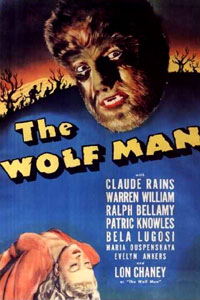

 Talbot believed he had killed only a wolf, & is reluctant to accept that the corpse was that of a man.
Talbot believed he had killed only a wolf, & is reluctant to accept that the corpse was that of a man. How much or how little Lon's classic film owes to the silent film The Wolf Man (1924) can never be known.
How much or how little Lon's classic film owes to the silent film The Wolf Man (1924) can never be known. There was, however, a legitimate supernatural silent film on the topic, The Werewolf (1913), from Canadian director Henry McRae.
There was, however, a legitimate supernatural silent film on the topic, The Werewolf (1913), from Canadian director Henry McRae.